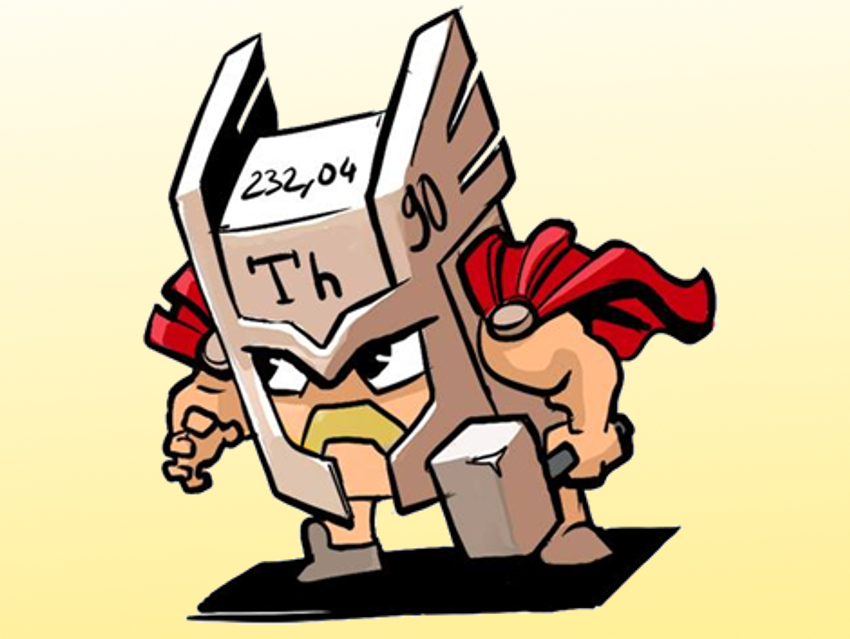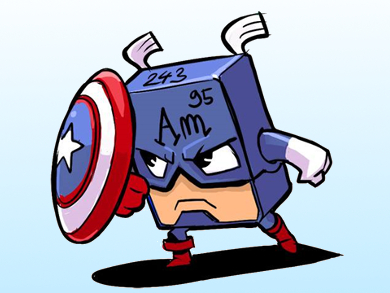The Top Five Chemical Components of Mjolnir
Thor is the God of Thunder in Norse mythology—but also in the Marvel comic book and cinematic universes. This article aims at hammering out the hypothetical chemistry behind the five most probable chemical components of his signature hammer, Mjolnir.
1 Introduction to the Marvel Universe
“Marvel is a cornucopia of fantasy, a wild idea, a swashbuckling attitude, an escape from the humdrum and the prosaic,” said the American comic book creator Stan Lee [1]. His genius facilitated the birth and fame of many popular icons, such as the Amazing Spider-Man, Black Panther, Captain America [2], and the Mighty Thor. Since the Walt Disney Company acquired Marvel Entertainment for over 4 billion USD in 2009 [3], these same superheroes have joined forces in the movie franchise “The Avengers”, hitting the big screen in the so-called Marvel Cinematic Universe (MCU).
Although Lee claimed himself to be “the least scientific person you’ll ever know” [4], many superheroes in Marvel Comics were inspired by chemistry and have names derived from the elements: e.g., Iron Man, Ironheart, Iron Monger, Iron Fist, Silver Surfer, Silver Sable, Silver Samurai, Silver Claw, Silver Fox [5], Silvermane, Quicksilver, Cobalt Man, Titanium Man, the Mercury Team, and Magneto’s Magnetic Men including Cobalt, Antimony, Iron, Bismuth, and Nickel.
Myths and legends have had an influence on scientists when coining the names of elements: e.g., tantalum, niobium, selenium, tellurium, and plutonium [6]. The most famous mythological character, who has inspired both chemical nomenclature and superhero comic book fiction, is resoundingly the Norse deity of thunder—Thor. Thor’s powers inspired the Swedish chemist Jöns Jacob Berzelius to name element 90 of the periodic table Thorium (Th) in 1828. They also led Stan Lee, along with script-writer Larry Lieber and illustrator Jack Kirby of Marvel Comics, to set in flight the hammer-throwing superhero in Journey into Mystery issue #83 in 1962. The immortal Asgardian God of Thunder, Thor Odinson, has since become a founding member of the Avengers superhero team and has appeared in a series of MCU movies.
Thor retains most of his powers without his hammer [7], but like Captain America’s shield and Iron Man’s armor, Mjolnir is a signature utility without which the hero becomes less “super”. Used throughout the Norse god’s adventures, Thor’s hammer has shown interesting magnetic, luminous, and thermal properties. Although such traits may be due to the chemical composition of Mjolnir, in Thor’s words, “It would require the wisdom of Odin for any mortal to say where science ends and fiction begins! [8]” Still, with due respect to Thor’s father Odin, the chemical bond between the superhuman and the chemical elements merits some illumination.
2 “I don’t buy it, the uru thing.”
Brainstorming on the composition of Thor’s hammer Mjolnir with Captain America and the Hulk, Ironman weighed in on his opinion of the fictional Asgardian metal uru, “How can there be a naturally occurring metal on Asgard that isn’t in the rest of the universe?” [9].
Based on the fact that Thor, with a few exceptions, is the only one able to lift Mjolnir, the trio consider other hammer components, including “dead star material” and the Higgs Boson—commonly known as the God particle—that provides mass to the building blocks of matter. Astrophysicists have hypothesized that a teaspoon of extremely dense neutron stars could weigh about as a much as a good-sized mountain [10]. However, more abundant terrestrial elements could also be likely components of Mjolnir.
2.1 Component #1: Iron?
Mjolnir was once stopped in flight, lifted, and controlled by the master of magnetism, Magneto [11,12]. Thus, the hammer likely contains the ferromagnetic substance iron (Fe, element 26). Weightless in the absence of gravity in space, Mjolnir has been handled both by Ironman [13] and the Red Hulk [14]. The latter even struck Thor with his own hammer. However, on re-entry on Earth, Mjolnir became immovable.
Iron could become an electromagnet upon Thor’s touch. Since the Earth’s core is mostly iron and has an electromagnetic field [15], only the touch of the “worthy” could deactivate the electromagnet in Mjolnir and allow it to be handled on Earth. Based on this assumption, engineer Allen Pan recreated Thor’s hammer, as shown on his YouTube channel Sufficiently Advanced. He used an electromagnet together with a fingerprint scanner to make the hammer immovable on any iron surface—by anyone except himself [16].
2.2 Component #2: Thorium?
The ignition of thorium (Th, element 90) may account for the bright white light emitted when Mjolnir strikes something, as seen on multiple Thor comic book covers and in Figure 1 [17]. Having a silvery-white luster like the colors of Thor’s armor, metallic thorium ignites upon heating in air, reacting with oxygen to produce brilliant white light and thorium dioxide (ThO2).
 |
|
Figure 1. A thorium component may be responsible for the white light when Mjolnir smashes something. |
Mjolnir’s capacity to serve as a static lantern [18] may be due to smoldering thorium dioxide. The latter has been used in incandescent gas mantle lanterns, which glow with a bright white flame. Invented by the chemist Carl Auer von Welsbach, these lanterns use a kerosene flame to burn a cloth bag covered primarily with thorium dioxide salts. These salts produce on oxidation an intense, long-lasting white light. Ignition of a thorium component may have given Mjolnir the lantern-like glow used by Thor to find his way through the Hall of the Lost [18].
A natural radioactive element, thorium exists in a stable single isotopic form (Th-232) that decays slowly, with a half-life around three-times the age of the Earth (≈14 billion years). Relative to uranium, thorium is three times more abundant on Earth, less suitable for making nuclear weapons, and offers superior properties as a safe fuel for use in nuclear fission to generate energy, with about 1000 times less radioactive waste [19,20]. Like the powerful pacifist god of lightning, thorium is a source of power not disposed to war and ready to fuel power plants to produce electricity [21].
Bruce Banner would note that the nuclear reaction of thorium produces uranium isotope U-232, which decays giving off gamma radiation. Gamma rays were the infamous cause of Banner’s ill-fated transformation into the Hulk. Gamma radiations from the thorium in Mjolnir may explain why when nearby, Thor irritates the Hulk with no apparent reason, as depicted in The Avengers movie (2012).
2.3 Component #3: A Triboluminescent Material?
On striking against a surface, Mjolnir and its fragmented pieces emit bright light as observed by Thor’s half-sister, the Goddess of Death, Hela Odinsdottir after smashing Mjolnir in the film Thor Ragnarok (2017). Triboluminescence is the scientific term for producing light (Latin: lumin) without heat by friction (rubbing, Greek: tribein) [22–24].
Amblygonite, calcite, feldspar, fluorite, lepidolite, mica, pectolite, quartz, and sphalerite all are minerals known to show triboluminescence upon striking, rubbing, or scratching [25]. Among triboluminescent (or smash glow) materials under consideration for impact sensors, europium tetrakis dibenzoylmethide triethylammonium (EuD4TEA, see Fig. 2) is promising [26–28]. It shines bright enough to be seen in daylight upon rubbing.
 |
|
Figure 2. Chemical structure of europium tetrakis dibenzoylmethide triethylammonium (EuD4TEA). |
On breaking the chemical bonds in triboluminescent materials, electrical charges separate and then reunite, giving off energy that causes atoms to ionize or fluoresce producing light. Crunching sugar crystals can cause triboluminescence, but the emitted ultraviolet and blue light is mostly undetectable by the naked eye. Wintergreen flavor (methyl salicylate) can absorb such energy and re-emit it in the visible spectrum. Such “lightning” from crunching down on a Wintergreen candy (see Video 1) has been recorded using high-speed photography by American engineer and science communicator Destin Sandlin and can be seen on his YouTube channel Smarter Every Day [29].
|
Video 1. Triboluminescent candy [29]. |
2.4 Component #4: Hafnium?
Mjolnir can endure tremendous heat without melting—such as the flaming sword of the fire demon Surtur [30]. The hammer has been touted to survive the heat from the heart of suns. At the core of the sun, temperatures reach over 15 million degrees! Sunspots are only as hot as 4,000 °C [31]. Of all pure metals, tungsten has the highest melting point at 3,422 °C. Alloys such as tantalum hafnium carbide (Ta4HfC5) melt at higher temperatures (in this case, 3,990 °C) [32]. Some compounds of nitrogen, carbon, and hafnium (Hf, element 72) have been predicted to liquefy at temperatures above 4,000 °C [33], which could account for the heat-resistant properties of Mjolnir.
2.5 Component #5: Plutonium?
Together, Thor and Mjolnir can produce a universe shaking thermo-blast capable of decimating large enemies such as Ego, the Living Planet [34]. On such rare occasions, Mjolnir can exert massive destructive power. On exposure to moist air, plutonium (Pu, element 94) forms oxides and hydrides, which flake off as a powder that can spontaneously ignite, generating intense heat.
Pyrophoric plutonium has caused serious fires at the United States Department of Energy facilities, including the infamous 1969 Mother’s Day fire at the Rocky Flats nuclear weapons facility near Denver. A few scraps of plutonium spontaneously ignited. This resulted in an explosion that nearly had devastating consequences to the surrounding metro area [35]. The heat generated by plutonium may account for the mystic energy blast from Mjolnir used to blind and incapacitate the gigantic villain Ego Prime to defend planet Earth [36].
3 Can the Components of Mjolnir Really Be Nailed Down?
Maybe on a Thursday in the future, but for now, no earthly material displays all the characteristics of Mjolnir. Tomorrow’s discoveries are today’s mystery. As technological advancements occur, the creation of such a stable alloy—call it “uru”—may arrive to showcase the abovementioned properties of iron, thorium, triboluminescent compounds, hafnium, and plutonium. As Thor states on the topic, “Your ancestors called it magic and you call it science. Well, I come from a place where they’re one and the same thing. [37]”
“Any sufficiently advanced technology is indistinguishable from magic.“
Arthur C. Clarke
References
[1] Quote from Stan Lee in S. Lee, Excelsior!: The Amazing Life of Stan Lee, Atria Books, 2002. ISBN: 978-0684873053.
[2] Y. Brouillette, W. D. Lubell, Molecular Marvels of Captain America, ChemViews Mag. 2018. https://doi.org/10.1002/chemv.201800111
[3] B. Barnes, M. Cieply, Disney Swoops Into Action, Buying Marvel for $4 Billion, New York Times, August 31, 2009.
[4] F. MacDonald, Stan Lee Said He Was “The Least Scientific Person You’ll Ever Know”, But He Inspired Us Anyway, ScienceAlert.com, 2018. (accessed July 16, 2019)
[5] Silver FOX, a marvel comic villain, is also the name of a molecule, see S. Garg et al., Taming of the Silver FOX, J. Am. Chem. Soc. 2010, 132, 26, 8888–8890. https://doi.org/10.1021/ja103935q
[6] R. Kyff, The Mythological Origins Of 5 Elements From The Periodic Table, Hartford Courant, May 30, 2013.
[7] As seen in the movie Thor: Ragnarok, 2017.
[8] Journey into Mystery with the Mighty Thor Vol. 1 #115, page 15, 1965.
[9] Deleted scene from the movie Avengers: Age of Ultron, 2015.
[10] D. Goldberg, What would a teaspoonful of neutron star do to you?, gizmodo.com, 2011. (accessed July 16, 2019)
[11] Journey into Mystery Vol. 1 #109, 1964.
[12] Ultimates Vol. 3 #4–5, 2008, and Ultimatum Vol. 1 #3–4, 2009. Magneto also deflected Mjolnir in Super Villain Team Up Vol. 1 #14, 1977.
[13] Avengers Vol. 1 #122, 1974.
[14] Hulk Vol. 2 #5, 2008.
[15] The Earth Is A Magnet, K&J Magnetics, www.kjmagnetics.com. (accessed July 16, 2019)
[16] Real Mjolnir (Thor’s Hammer) – Electromagnet, Fingerprint Scanner | Sufficiently Advanced, Allen Pan – Sufficiently Advanced, youtube.com, October 11, 2015. (accessed July 16, 2019)
[17] Thor Vol. 3 #9, 2008.
[18] Thor: God of Thunder Vol. 1 #3, 2012.
[19] C. Bungau et al., GEANT4 Studies of the Thorium Fuel Cycle, PAC 2011 Particle Accelerator Conference Proceedings. 2011, 2178–2180.
[20] Thorium, World Nuclear Association, world-nuclear.org. (accessed July 16, 2019)
[21] S. Burns, Is Thorium the Fuel of the Future?, MetalMiner, January 8, 2013. (accessed July 16, 2019)
[22] A. J. Walton, Triboluminescence, Adv. Phys. 1977, 26, 887. https://doi.org/10.1080/00018737700101483
[23] D. O. Olawale et al., Introduction to Triboluminescence in D. O. Olawaleet al. (Eds), Triboluminescence. Springer, 2016.
[24] Z. Wang, F. Wang, Triboluminescence: Materials, Properties, and Applications, IntechOpen 2018. https://doi.org/10.5772/intechopen.81444
[25] A. M. Helmenstine, Why Wintergreen Lifesavers Spark in the Dark: Triboluminescence, ThoughtCo., August 1, 2018. (accessed July 16, 2019)
[26] R. S. Fontenot et al., Triboluminescent materials for smart sensors, Mater. Today 2011, 14, 292–293. https://doi.org/10.1016/S1369-7021(11)70147-X
[27] C. R. Hurt et al., High Intensity Triboluminescence in Europium Tetrakis (Dibenzoylmethide)-triethylammonium, Nature 1966, 212, 179. https://doi.org/10.1038/212179b0
[28] The synthesis of Europium Tetrakis (Dibenzoylmethide)Triethylammonium was recorded by chemist and YouTuber NurdRage and can be seen at Make SMASH-GLOW Crystals!!!, NurdRage, youtube.com, January 10, 2010. (accessed July 16, 2019)
[29] LIFE SAVER LIGHTNING (Triboluminescence Slow Motion) – Smarter Every Day, Smarter Every Day 2, youtube.com, April 30, 2017. (accessed July 16, 2019)
[30] In multiple occasions in the comics such as on the covers of Thor Vol. 1 #176, 1970, and Thor Vol. 2 #40, 1998, as well as in the movie Thor: Ragnarok, 2017.
[31] T. Sharp, How Hot Is The Sun?, space.com, October 19, 2017. (accessed July 16, 2019)
[32] R. A. Andrievskii, et al., Melting point in systems ZrC-HfC, TaC-ZrC, TaC-HfC, Soviet Powder Metall. Met. Ceram. 1967, 6, 65–67. https://doi.org/10.1007/BF00773385
[33] Q.-J. Hong, A. van de Walle, Prediction of the material with highest known melting point from ab initio molecular dynamics calculations, Phys. Rev. B 2015, 92, 020104(R). https://doi.org/10.1103/PhysRevB.92.020104
[34] Thor Vol. 1 #133, 1966.
[35] A. Cohen, A September 11th Catastrophe You’ve Probably Never Heard About, The Atlantic, September 10, 2012.
[36] Thor Vol. 1 #202, 1972.
[37] Spoken by Thor to his human girlfriend, astrophysicist Jane Foster, in the movie Thor, 2011.
Acknowledgments
The authors thank Nicolas Ughen and Arturo Palacios for chemically heroic illustrations.
Author Information
Yann Brouillette (Corresponding Author)
Chemistry Department, Dawson College, 3040 Sherbrooke St. W., Westmount, Quebec, Canada H3Z 1A4
William D. Lubell
Département de Chimie, Université de Montréal, C.P. 6128, Succursale Centre Ville, Montréal, Québec, Canada H3C 3J7
Also of Interest

The hypothetical science behind the transformation of Bruce Banner and his cousin into green superheroes

The top five chemical components of Thor’s hammer Mjolnir

The hypothetical (bio-)chemistry behind the transformation of a frail soldier into a comic book superhero



